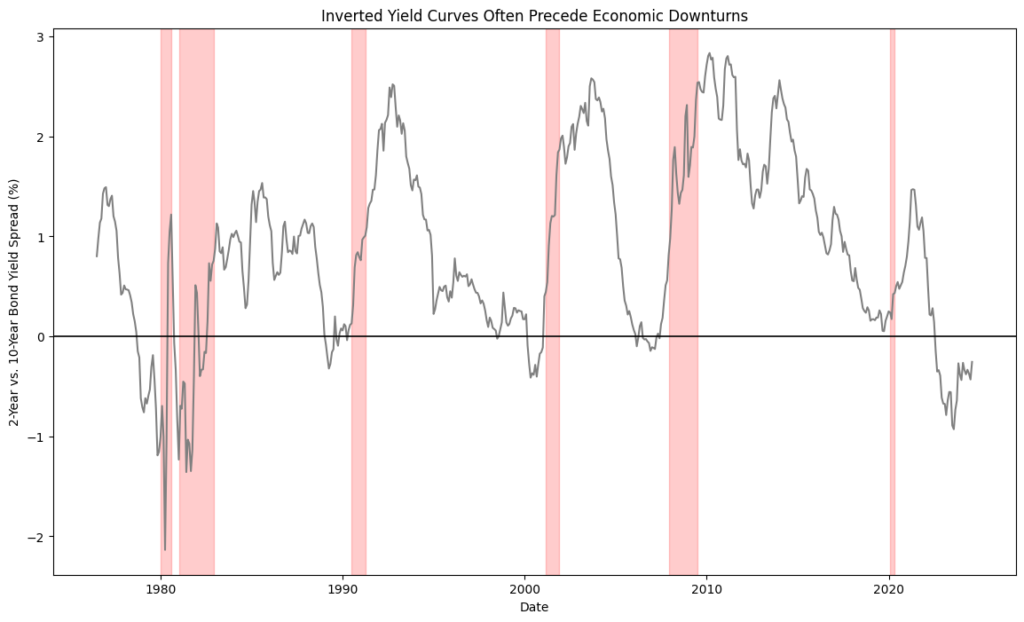In recent months, the financial world has been abuzz with discussions of an impending recession, largely due to the appearance of an inverse yield curve. An inverse yield curve, also known as an inverted yield curve, occurs when short-term government bonds offer higher yields than long-term bonds. For instance, the 2-year interest rate is currently ~4.4%, compared to ~4.2% for the 10-year rate. Typically, longer-term bonds provide higher yields to compensate investors for the increased risk of holding debt for extended periods. When this relationship flips, it often signals a lack of confidence in the economy’s short-term prospects.
The current yield curve inversion, ongoing since July 2022, has become the longest on record. According to Deutsche Bank, it has already exceeded the previous record of 624 days set in 1978. Therefore, it is crucial for investors to understand its implications when constructing their investment portfolios.
Economic Implications of the Inverse Curve
Historically, the inverted yield curve has been a reliable predictor of economic downturns. Since 1955, an inverted yield curve has preceded every U.S. recession with only one false positive signal in 1960, making it a closely watched barometer.

The inversion’s impact extends beyond prediction, triggering a chain of economic reactions. Banks, which typically borrow at short-term rates and lend at long-term rates, may become more conservative in their lending practices. Simultaneously, businesses and consumers anticipating a downturn often reduce spending and investment, leading to decreased demand for goods and services. This collective belt-tightening by banks, businesses, and consumers contributes to economic deceleration, ultimately creating a self-fulfilling prophecy of a recession.
Is the Prophecy Fulfilled?
Despite the inverse yield curve’s historical accuracy in predicting recessions, the current market conditions present a puzzling scenario. The S&P 500 has gained between 6%-7% this year, even with the recent market sell-offs. This apparent contradiction may be attributed to factors such as market expectations of future rate cuts or the influence of other economic indicators.

To gauge the true health of markets, a more comprehensive analysis of other economic indicators is necessary. The labor market has shown remarkable resilience, with unemployment rates hovering near historic lows. Additionally, consumer spending, a crucial driver of the U.S. economy, has remained robust despite inflationary pressures and high interest rates. This resilience can be attributed to the excessive fiscal spending during the COVID-19 pandemic and the high U.S. national debt, which have provided a temporary buffer against economic slowdowns.
However, not all economic indicators paint a rosy picture. Manufacturing indices, such as the Purchasing Managers’ Index (PMI), have fluctuated, occasionally indicating contraction in the manufacturing sector. Corporate earnings reports have also been mixed, with some sectors thriving while others face significant challenges. Furthermore, the housing market, which is highly sensitive to interest rate changes, has experienced a sharp decline, with home sales reaching near 10-year lows.
These conflicting signals create a challenging environment for investors, necessitating a careful and strategic approach to portfolio management.
Is the Prophecy Fulfilled?
-
Defensive Sectors
During periods of economic uncertainty, certain sectors tend to outperform. Focus on industries that provide essential goods and services, which typically maintain steady demand regardless of economic conditions:
- Consumer Staples: Companies that produce household necessities, such as food, beverages, and personal care items. Examples include grocery chains and discount retailers.
- Healthcare: Companies involved in the production and distribution of medical goods and services, such as pharmaceutical firms, healthcare providers, and medical device manufacturers.
- Utilities: Companies that provide essential services like electricity, gas, and water.
These sectors often offer more stable revenues, cash flows, and dividends, providing a buffer against potential market volatility.
-
Quality Over Growth
In anticipation of potential economic challenges, prioritize companies with strong fundamentals over high-growth prospects. Look for businesses with:
- Robust balance sheets
- Consistent cash flows
- Sustainable dividend policies
- Low debt levels
- Proven track records of navigating economic cycles
Companies like Microsoft or Coca-Cola, which have demonstrated these qualities over time, are often better equipped to weather economic downturns and may provide more stable returns in an uncertain environment.
-
Alternatives and Commodities
Diversifying into alternative asset stocks can help hedge against risks associated with traditional stocks and bonds. Investors might consider allocating a portion of their portfolios to:
- Gold and Precious Metals ETFs: Often seen as safe-haven assets during economic uncertainty and inflationary periods.
- Commodity-Related Equities: Investing in stocks of companies involved in the production, processing, or distribution of commodities like oil, energy, or agricultural products can act as an inflation hedge and may benefit from supply constraints.
- Real Estate Investment Trusts (REITs): While REITs may face near-term challenges, they can provide inflation protection and income over the long term.
The inverse yield curve presents a unique economic landscape, emphasizing the importance of a balanced and informed investment approach. Investors should focus on strategic diversification, quality investments, and defensive sectors while remaining flexible to capitalize on emerging opportunities. Aligning these strategies with personal financial goals and risk tolerance, staying informed and disciplined, and seeking professional guidance can help ensure investment resilience during uncertain times.
Created by: Pankhti Antani, Financial Analyst
Twitter Linkedin Medium





